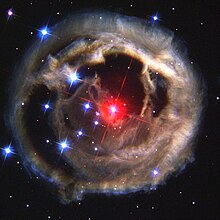Spike (flexion)
Spikes (English, in German about sting, point), also light cross , are called the star-shaped rays that can be seen in some photographs. They are diffraction structures.

In astronomy
Spikes can often be seen on astronomical photos from reflecting telescopes . They are caused by diffraction on the mostly cross-shaped suspension of the secondary mirror in the telescope, while the circular telescope aperture is responsible for the small circular diffraction disks . The photo of the group of stars was taken with the Hubble Space Telescope . Although the diffraction disks are of the same size, bright stars appear larger due to overexposure in the recording material. The extended spikes of the central star V838 Monocerotis even reveal the brightness modulations of the diffraction. Higher order diffractions outside the main spikes are too faint and therefore not recognizable.
The small picture in the diagram on the right shows a circular disc, crossed by two right-angled lines. The main picture is the Fourier transform of this circular disk. The long spikes and the weak diffraction rings are clearly visible.
In other photography
While spikes are undesirable in astronomy, but cannot be avoided, photography uses photography as a means of artistic creation. Elongated grooves on a camera filter give highlights a star-shaped appearance.
Individual evidence
- ↑ Archived copy ( Memento of the original from September 28, 2013 in the Internet Archive ) Info: The archive link was inserted automatically and has not yet been checked. Please check the original and archive link according to the instructions and then remove this notice. (PDF; 13.9 MB)
